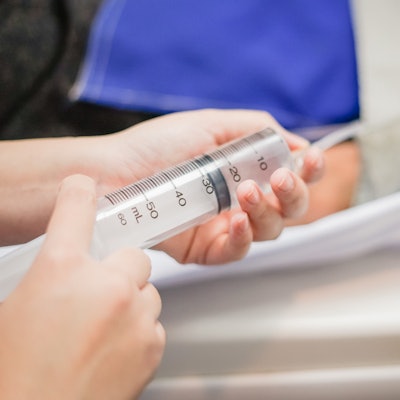
When it comes to head and neck imaging, MRI and ultrasound offer sound alternatives to CT with iodinated contrast, and use of the modalities could mitigate crises such as contrast shortages, according to a commentary published September 20 in the Journal of Medical Imaging and Radiation Oncology.
The dramatic shortage of any key material used in patient care demands immediate and flexible response, wrote a team led by Dr. Timothy Fiori of Fiona Stanley Hospital in Perth, Australia. Health departments and imaging providers there quickly assessed the use of CT contrast and put new actions into place to conserve it.
"Strategies include utilizing alternative imaging modalities to answer clinical questions, weight-based contrast dosing and lower kVp CT protocols to improve the conspicuity of iodinated contrast media," the group explained.
The iodinated contrast shortage was due in large part to a May lockdown of Shanghai, China intended to avoid a COVID-19 outbreak; the lockdown blocked GE Healthcare's ability to distribute its Omnipaque contrast agent. The crisis was mostly resolved by June, but healthcare providers around the world warn that vulnerabilities in the supply chain for materials such as contrast agents continue and must be addressed.
To this end, Fiori and colleagues outlined the follow best practices for head and neck imaging to offer a framework for conserving contrast in acute care settings.
- Thyroid: Incidental thyroid nodules can be identified on carotid Doppler ultrasound, chest CT, or PET/CT; ultrasound helps clinicians determine whether a patient would benefit from fine-needle aspiration. Hyperthyroidism can be worked up with thyroid scintigraphy, and goiter can be imaged using CT without contrast.
- Salivary glands: Both obstruction of and masses in these glands can be evaluated with ultrasound, the group wrote. Ultrasound findings may suggest that CT or MRI exams would be beneficial to further work up larger or malignant lesions. CT provides clinical data regarding bone involvement in salivary gland disease but can be done without contrast for this indication.
- Pediatrics: For neck masses, ultrasound is again the first imaging modality for characterizing the mass. If malignancy is suspected, MRI or contrast-enhanced CT may be used. Contrast CT is recommended for suspected orbital, temporal bone, or intracranial pathologies. Finally, for children suffering from stridor, the first line for diagnosis is laryngoscopy or bronchoscopy, but contrast-enhanced CT is recommended in more severe cases.
- Staging head and neck cancer: MRI is the go-to modality for head and neck cancer staging, although noncontrast CT is a useful alternative, the researchers wrote. Contrast-enhanced CT is recommended over MRI for staging of tumors in the larynx and hypopharynx because patients with these conditions may have compromised airways and CT exams are shorter than MRI exams.
The bottom line is that MRI and ultrasound are useful alternatives to contrast-enhanced CT imaging for head and neck abnormalities, according to the authors.
"For the routine assessment of non-acute pediatric and adult head and neck presentations, use of contrast-enhanced CT can be either safely minimized or avoided, to conserve iodinated contrast media," they concluded. "This can be achieved through ... use of alternative modalities [such as] ultrasound and MRI, [which] not only conserve iodinated contrast media but also avoid ionizing radiation."



















